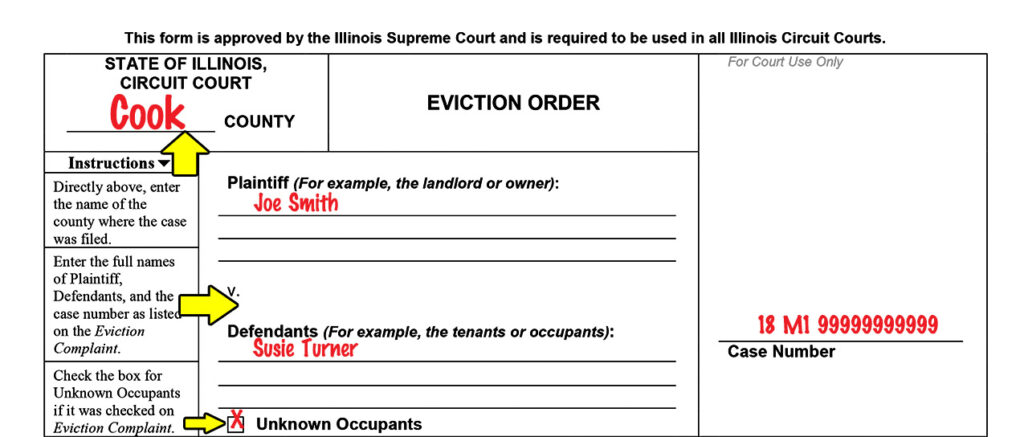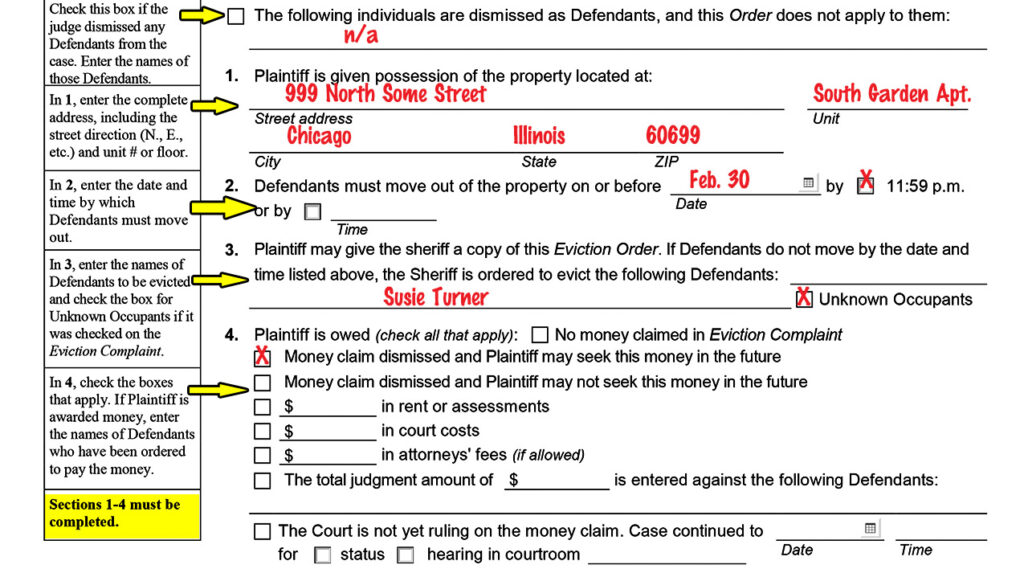 New Eviction Form Released
New Eviction Form Released
Back in September, I wrote about changes made to the Forcible Entry and Detainer Eviction Act. The gist of the changes was to get rid of the words “Forcible Entry and Detainer” and replace them with “Eviction” and to create a “standardized” eviction order. The law went into effect on January 1, 2018 and the state-standardized Eviction Order (known as form E-O 3500-2 in Cook County) is now available in courtrooms and online. The form is radically different than the Order for Possession form that many Chicagoland landlords may be used to. Let’s take a closer look.
The first thing to notice is that the form does not look like any other court form in Cook County. It is also apparent that the drafters of the form want it to be very accessible to the user, placing instructions down the left side of the form. The top portion of the form is general housekeeping. The first instruction tells a landlord to insert the name of the County in the top left corner box. The next instruction requires inserting the names of the plaintiffs, defendants, and cans number. The instruction after that indicates a checkbox should be checked in the case that “unknown occupants” have also been named as defendants.
 The form is then separated by a gray section that contains a notice to tenants making clear that the Eviction Order “is a judgment against you” and other such information and an admonishment to the defendant not to sign the order if the landlord has entered an agreement to let the tenant stay in the property or the plaintiff has agreed to dismiss the case if the tenant moves by a certain date. I can conceive of situations that don’t fit this language and I fear tenants may rely too heavily on it to great inefficiency in the system.
The form is then separated by a gray section that contains a notice to tenants making clear that the Eviction Order “is a judgment against you” and other such information and an admonishment to the defendant not to sign the order if the landlord has entered an agreement to let the tenant stay in the property or the plaintiff has agreed to dismiss the case if the tenant moves by a certain date. I can conceive of situations that don’t fit this language and I fear tenants may rely too heavily on it to great inefficiency in the system.
 The next section is optional and indicates to check a box if certain defendants have been dismissed. Next we move on to the four additional sections of the order. In section 1, the full, complete and proper address of the property where the tenant will be evicted should be inserted. The instructions make special note to include street direction, unit number or floor. My own experience has been that if these things are not correct on an eviction order, it is possible that the Cook County Sheriff will not execute the eviction. In section 2, the date and time the tenant should vacate by will be inserted. Inserting an option for a time other than 11:59pm is new to this form and could be useful for agreed orders. In Section 3, the names of the defendants being evicted are entered along with a checkbox for unknown occupants if they are to be included. Section 4 deals with money damages and includes a breakdown of rent, court costs, and attorneys fees. There is also an option for the money count to be dismissed (with or without prejudice) and for the money count to be continued to a future date. The instructions note that items 1-4 must all be completed.
The next section is optional and indicates to check a box if certain defendants have been dismissed. Next we move on to the four additional sections of the order. In section 1, the full, complete and proper address of the property where the tenant will be evicted should be inserted. The instructions make special note to include street direction, unit number or floor. My own experience has been that if these things are not correct on an eviction order, it is possible that the Cook County Sheriff will not execute the eviction. In section 2, the date and time the tenant should vacate by will be inserted. Inserting an option for a time other than 11:59pm is new to this form and could be useful for agreed orders. In Section 3, the names of the defendants being evicted are entered along with a checkbox for unknown occupants if they are to be included. Section 4 deals with money damages and includes a breakdown of rent, court costs, and attorneys fees. There is also an option for the money count to be dismissed (with or without prejudice) and for the money count to be continued to a future date. The instructions note that items 1-4 must all be completed.
 The form ends by indicating that the Eviction Order is a “final order” with the language that “the Court finds there is no just reason to delay the enforcement or appeal of this eviction order and then has space for the contact information of the person completing the form and the signature of the judge entering the order.
The form ends by indicating that the Eviction Order is a “final order” with the language that “the Court finds there is no just reason to delay the enforcement or appeal of this eviction order and then has space for the contact information of the person completing the form and the signature of the judge entering the order.
 Longtime landlords will notice that gone is the four-part multicolored carbon-copy form that used to be used in Cook County evictions. Landlords will need to bring sufficient copies of the notice with them to be stamped so that they have a copy to provide to the Sheriff (which will still need to be stamped by the Court Clerk before placement) and for their records.
Longtime landlords will notice that gone is the four-part multicolored carbon-copy form that used to be used in Cook County evictions. Landlords will need to bring sufficient copies of the notice with them to be stamped so that they have a copy to provide to the Sheriff (which will still need to be stamped by the Court Clerk before placement) and for their records.
Like all things that are new, the form will take some getting used to. I’m not really sure an upgrade was required. In fact, there are plenty of things wrong with the (newly named) Eviction Act that need revision and the Eviction Order was not one of them. However, it makes sense for landlords to be aware of the new form on a go forward basis.
